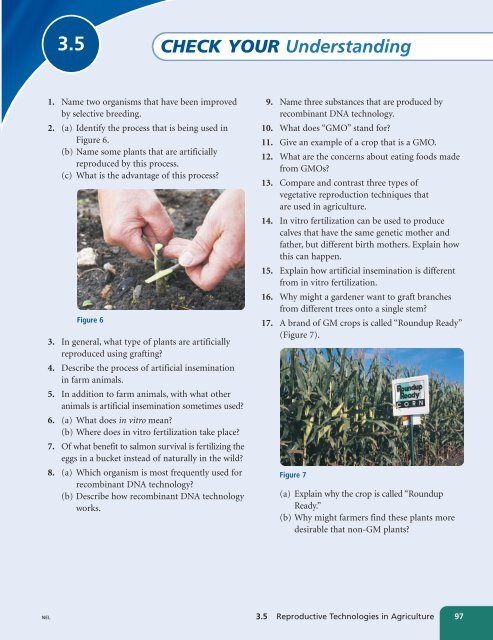Unit A Reproduction
Unit A Reproduction
Unit A Reproduction
Create successful ePaper yourself
Turn your PDF publications into a flip-book with our unique Google optimized e-Paper software.
3.5 CHECK YOUR Understanding<br />
1. Name two organisms that have been improved<br />
by selective breeding.<br />
2. (a) Identify the process that is being used in<br />
Figure 6.<br />
(b) Name some plants that are artificially<br />
reproduced by this process.<br />
(c) What is the advantage of this process?<br />
Figure 6<br />
3. In general, what type of plants are artificially<br />
reproduced using grafting?<br />
4. Describe the process of artificial insemination<br />
in farm animals.<br />
5. In addition to farm animals, with what other<br />
animals is artificial insemination sometimes used?<br />
6. (a) What does in vitro mean?<br />
(b) Where does in vitro fertilization take place?<br />
7. Of what benefit to salmon survival is fertilizing the<br />
eggs in a bucket instead of naturally in the wild?<br />
8. (a) Which organism is most frequently used for<br />
recombinant DNA technology?<br />
(b) Describe how recombinant DNA technology<br />
works.<br />
9. Name three substances that are produced by<br />
recombinant DNA technology.<br />
10. What does “GMO” stand for?<br />
11. Give an example of a crop that is a GMO.<br />
12. What are the concerns about eating foods made<br />
from GMOs?<br />
13. Compare and contrast three types of<br />
vegetative reproduction techniques that<br />
are used in agriculture.<br />
14. In vitro fertilization can be used to produce<br />
calves that have the same genetic mother and<br />
father, but different birth mothers. Explain how<br />
this can happen.<br />
15. Explain how artificial insemination is different<br />
from in vitro fertilization.<br />
16. Why might a gardener want to graft branches<br />
from different trees onto a single stem?<br />
17. A brand of GM crops is called “Roundup Ready”<br />
(Figure 7).<br />
Figure 7<br />
(a) Explain why the crop is called “Roundup<br />
Ready.”<br />
(b) Why might farmers find these plants more<br />
desirable that non-GM plants?<br />
NEL<br />
3.5 Reproductive Technologies in Agriculture 97

















